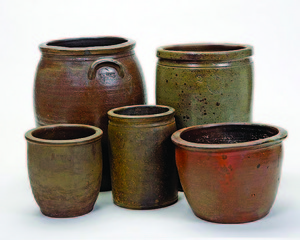

Examples of Edward Mort's pottery. (Photo by James H. Price)
The pottery group shown here is a good representation of local stoneware. Included are jars, crocks and milk pans, all made in Washington County, Va., during the fourth quarter of the 19th century when utilitarian pieces like these were still made by hand for daily use. The local pottery industry was large, and many potters clustered in two locations along the middle and north forks of the Holston River, near the water source and where the clay was good. Those on the North Fork located their shops in the Craig's Mill and Alum Wells area.
One of these potters was E. W. Mort, and the detailed image of his rectangular stamp tells us his shop was at Alum Wells. The stamp appears just under one of the lug handles on the large 12" high crock at the back left of the pottery group. The shape of the handles, the slightly bulbous sides of the crock and its brownish color are typical of Washington County stoneware.
Edward Mort was born at mid-century in the Shenandoah Valley town of Strasburg. His father was a painter, and his grandparents and his great-grandparents were also from the upper end of the Valley. When Edward's father was killed in the Civil War, his mother took young Edward and moved to her childhood home, Washington County. Though Strasburg was a significant pottery hub, there is no evidence that Edward formally tried his hand at pottery there. He may have learned his skills as a potter only after his move to Southwest Virginia, since his residence in 1880 was near the North Fork cluster of Washington County potters. An ad he placed in the Bristol Herald Courier reveals that he had a pottery shop at Alum Wells that was in full operation by 1881 and was "keeping on sale a full line of assorted stoneware."
The Cunningham family also lived nearby on the North Fork, and a romance soon kindled between Edward and Amanda Cunningham. They married on May 10, 1893, when he was 40 and she was 28. Many potters combined their trade with farming, but Edward Mort combined his with the church, and, by the time of his marriage to Amanda, was already a Methodist minister. After the wedding, he concentrated on his church work and spent less and less time making pottery. However, despite the relatively short span of his working period, a number of Mort pieces survive.
By 1910, he and Amanda had three children – James, Ruby and Mary George – and had moved to Sevierville, Tenn.
In 1923, Edward William Mort, potter and minister, died at the age of 70 and was buried as a clergyman in the Holston Conference Cemetery at Emory, Va. His Alum Wells kiln site was rediscovered in 2002 during research sponsored by the Virginia Department of Historic Resources, Washington County, and William King Regional Arts Center (William King Museum).
Edward W. Mort, Potter and Minister is adapted from "Backcountry Makers: An Artisan History of Southwest Virginia & Northeast Tennessee." This is the ninth in a series of articles related to this new book by Betsy K. White. Featuring more than 200 color images, it is newly published by the University of Tennessee Press. "Backcountry Makers" is White's second book on the history of the region's material culture. The first, "Great Road Style: the Decorative Arts Legacy of Southwest Virginia & Northeast Tennessee" was published in 2006 by the University of Virginia Press.